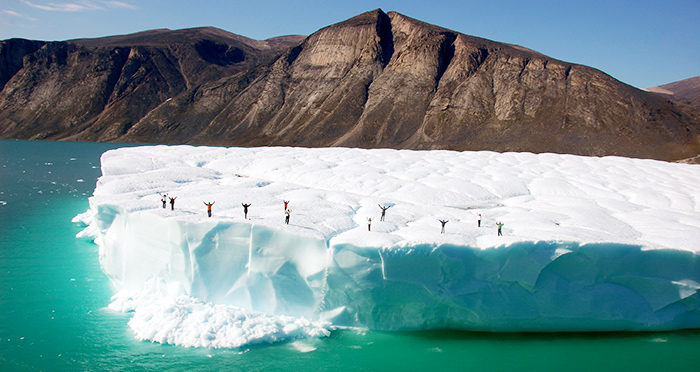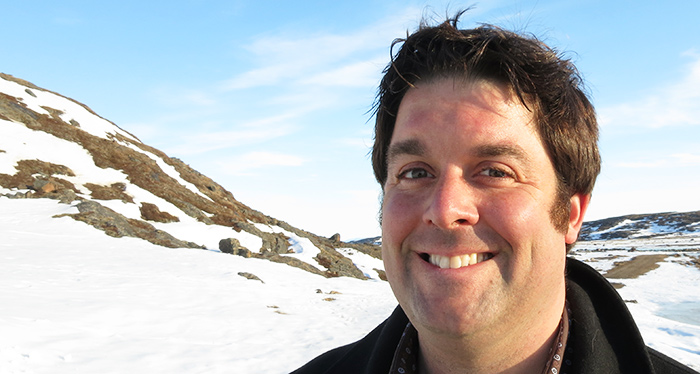
Graham Dickson is the founder of Arctic Kingdom Polar Expeditions (arctickingdom.com), having led more than fifty polar expeditions for adventurers, scientists, TV crews, tourists, and divers. He’s dived with walrus, narwhal, belugas, and the enormous Greenland sharks, and he led the first ice-climbing expedition to scale icebergs in Nunavut. Arctic Kingdom offers a range of bucket list backcountry Arctic adventures, wildlife safaris, and diving excursions. Robin caught up with Graham via satellite in remote Baffin Island.
RE: In the chase for one-of-a-kind adventures, why should people think North? What makes it different from other places in Canada?
GD: The Arctic is Canada’s third seacoast, and the location of ani- mal migrations that rival those of the African plains. Narwhal and caribou move from winter ranges to summer ranges. Polar bear and ring seals follow the ice.
RE: Diving in the North sounds surreal? What can one expect, and wait, isn’t it freezing?
GD: I’ve been diving in the North since 1999. I admit it isn’t tropical, but with the right gear, divers are comfortable. Our Baffin Island Dive Safari coincides with the annual migration of narwhal — the single-tusked whale that was the inspiration for unicorn legends. The sea ice has not completely
melted, so we can dive near icebergs frozen in place. Underwater photography opportunities are amazing.
RE: Wildlife can be scarce in a region as vast as Canada’s North. How do you keep your guest’s expectations in check?
GD: Wildlife is scarce if the conditions aren’t right: reduced food sources, reduced sea ice — even too much sea ice — bad weather. That is the challenge for us. We use the expertise of the people who have called the North home for thousands of years. They can read the ice, the land, and they understand the ways of the wildlife. Without their knowledge and experience, our job would be much harder.
RE: When’s the best time of year to visit the ice floe, and why?
GD: End of May into June, in the Arctic spring when the ice is still strong, but open water appears. That’s when the marine mammals emerge.
RE: What’s your favourite part of Canada’s North?
GD: If I have to pick one part of the Canadian North … I would pick Baffin Island. That is my home. I love the diversity of the landscape — from towering cliffs to tundra. From freshwater lakes to the sea- coast. Midnight sun or northern lights — Baffin Island delivers all the icons of the Canadian Arctic.

RE: Not everyone can join you for a hot air balloon over the ice-floe. What belongs on everyone’s Northern Canada Bucket List?
GD: If you have a long weekend — Friday to Sunday — you can check the northern lights or the midnight sun off your bucket list. Iqaluit is only a three-hour direct flight from Ottawa. Stay for an extra night, and we can arrange to fly you to photograph wildlife or enjoy champagne on a glacier.
RE: Are there misconceptions about the North you want to clear up? I keep telling people that it does actually warm up in the summer!
GD: Thank you for that … in mid-July some of our guests can be seen in T-shirts sunning themselves on our camp chairs! The Canadian Arctic is not an inferior Antarctica. The northern polar region is an ocean surrounded by land, whereas Antarctica is a continent surrounded by water. You can’t say you are a polar traveller without having visited the Arctic.
RE: We’ve come a long way from the Franklin expedition. Is a northern expedition still considered dangerous?
GD: Life in the North requires a greater attention to detail, per- haps, than Southern Canada. Weather changes hourly. If the
wind changes direction, the ice that had been floating away from land earlier could be driven back to shore. Our field team members are experienced and wise enough to rely on the advice of Inuit guides. We make sure our guests are fully briefed about visiting the North. We have been operating trips in the Arctic safely for nearly two decades. And we plan to continue to do that for many decades more.
